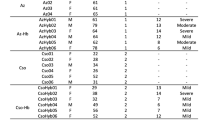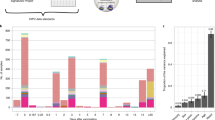Abstract
Despite its eradication over 30 years ago, smallpox (as well as other orthopox viruses) remains a pathogen of interest both in terms of biodefense and for its use as a vector for vaccines and immunotherapies. Here we describe the application of mRNA-Seq transcriptome profiling to understanding immune responses in smallpox vaccine recipients. Contrary to other studies examining gene expression in virally infected cell lines, we utilized a mixed population of peripheral blood mononuclear cells in order to capture the essential intercellular interactions that occur in vivo, and would otherwise be lost, using single cell lines or isolated primary cell subsets. In this mixed cell population we were able to detect expression of all annotated vaccinia genes. On the host side, a number of genes encoding cytokines, chemokines, complement factors and intracellular signaling molecules were downregulated upon viral infection, whereas genes encoding histone proteins and the interferon response were upregulated. We also identified a small number of genes that exhibited significantly different expression profiles in subjects with robust humoral immunity compared with those with weaker humoral responses. Our results provide evidence that differential gene regulation patterns may be at work in individuals with robust humoral immunity compared with those with weaker humoral immune responses.
This is a preview of subscription content, access via your institution
Access options
Subscribe to this journal
Receive 6 digital issues and online access to articles
$119.00 per year
only $19.83 per issue
Buy this article
- Purchase on Springer Link
- Instant access to full article PDF
Prices may be subject to local taxes which are calculated during checkout


Similar content being viewed by others
References
Fenner F . Smallpox and its Eradication. World Health Organization: Geneva, 1988.
Henderson DA, Inglesby TV, Bartlett JG, Ascher MS, Eitzen E, Jahrling PB et al. Smallpox as a biological weapon: medical and public health management. Working Group on Civilian Biodefense. JAMA 1999; 281: 2127–2137.
Kennedy RB, Ovsyannikova I, Poland GA . Smallpox vaccines for biodefense. Vaccine 2009; 27 (Suppl 4): D73–D79.
Di Giulio DB, Eckburg PB . Human monkeypox: an emerging zoonosis. Lancet Infect Dis 2004; 4: 15–25.
Trindade GS, Guedes MI, Drumond BP, Mota BE, Abrahao JS, Lobato ZI et al. Zoonotic vaccinia virus: clinical and immunological characteristics in a naturally infected patient. Clin Infect Dis 2009; 48: e37–e40.
Essajee S, Kaufman HL . Poxvirus vaccines for cancer and HIV therapy. Expert Opinion Biol Ther 2004; 4: 575–588.
Gilbert PA, McFadden G . Poxvirus cancer therapy. Recent Pat Antiinfect Drug Discov 2006; 1: 309–321.
Arlen PM, Skarupa L, Pazdur M, Seetharam M, Tsang KY, Grosenbach DW et al. Clinical safety of a viral vector based prostate cancer vaccine strategy. J Urol 2007; 178 (4 Pt 1): 1515–1520.
Lee JS, Hadjipanayis AG, Parker MD . Viral vectors for use in the development of biodefense vaccines. Adv Drug Deliv Rev 2005; 57: 1293–1314.
Oberg AL, Kennedy RB, Li P, Ovsyannikova IG, Poland GA . Systems biology approaches to new vaccine development. Curr Opin Immunol 2011; 23: 436–443.
Poland GA, Jacobson RM, Ovsyannikova IG . Trends affecting the future of vaccine development and delivery: the role of demographics, regulatory science, the anti-vaccine movement, and vaccinomics. Vaccine 2009; 27: 3240–3244.
Poland GA, Kennedy RB, Ovsyannikova IG . Vaccinomics and personalized vaccinology: is science leading us toward a new path of directed vaccine development and discovery? PLoS Pathog 2011; 7: e1002344.
Poland GA, Ovsyannikova IG, Jacobson RM . Personalized vaccines: the emerging field of vaccinomics. Expert Opin Biol Ther 2008; 8: 1659–1667.
Poland GA, Ovsyannikova IG, Jacobson RM, Smith DI . Heterogeneity in vaccine immune response: the role of immunogenetics and the emerging field of vaccinomics. Clin Pharmacol and Ther 2007; 82: 653–664.
Poland GA, Ovsyannikova IG, Kennedy RB, Haralambieva IH, Jacobson RM . Vaccinomics and a new paradigm for the development of preventive vaccines against viral infections. OMICS 2011; 15: 625–636.
Mack TM, Noble J Jr., Thomas DB . A prospective study of serum antibody and protection against smallpox. Am J Trop Med Hyg 1972; 21: 214–218.
Banchereau R, Jordan-Villegas A, Ardura M, Mejias A, Baldwin N, Xu H et al. Host immune transcriptional profiles reflect the variability in clinical disease manifestations in patients with Staphylococcus aureus infections. PLoS One 2012; 7: e34390.
Rubins KH, Hensley LE, Relman DA, Brown PO . Stunned silence: gene expression programs in human cells infected with monkeypox or vaccinia virus. PLoS One 2011; 6: e15615.
Yang Z, Bruno DP, Martens CA, Porcella SF, Moss B . Simultaneous high-resolution analysis of vaccinia virus and host cell transcriptomes by deep RNA sequencing. Proc Natl Acad Sci USA 2010; 107: 11513–11518.
Alkhalil A, Hammamieh R, Hardick J, Ichou MA, Jett M, Ibrahim S . Gene expression profiling of monkeypox virus-infected cells reveals novel interfaces for host-virus interactions. Virol J 2010; 7: 173.
Brum LM, Lopez MC, Varela JC, Baker HV, Moyer RW . Microarray analysis of A549 cells infected with rabbitpox virus (RPV): a comparison of wild-type RPV and RPV deleted for the host range gene, SPI-1. Virology 2003; 315: 322–334.
Sanchez-Puig JM, Sanchez L, Roy G, Blasco R . Susceptibility of different leukocyte cell types to Vaccinia virus infection. Virol J 2004; 1: 10.
Yu Q, Jones B, Hu N, Chang H, Ahmad S, Liu J et al. Comparative analysis of tropism between canarypox (ALVAC) and vaccinia viruses reveals a more restricted and preferential tropism of ALVAC for human cells of the monocytic lineage. Vaccine 2006; 24: 6376–6391.
Griffin JD, Ritz J, Nadler LM, Schlossman SF . Expression of myeloid differentiation antigens on normal and malignant myeloid cells. J Clin Invest 1981; 68: 932–941.
Haziot A, Ferrero E, Kontgen F, Hijiya N, Yamamoto S, Silver J et al. Resistance to endotoxin shock and reduced dissemination of gram-negative bacteria in CD14-deficient mice. Immunity 1996; 4: 407–414.
Spilsbury K, O'Mara MA, Wu WM, Rowe PB, Symonds G, Takayama Y . Isolation of a novel macrophage-specific gene by differential cDNA analysis. Blood 1995; 85: 1620–1629.
Wang Y, Chaudhri G, Jackson RJ, Karupiah G . IL-12p40 and IL-18 play pivotal roles in orchestrating the cell-mediated immune response to a poxvirus infection. J Immunol 2009; 183: 3324–3331.
Haralambieva IH, Ovsyannikova IG, Dhiman N, Kennedy RB, O'Byrne M, Pankratz VS et al. Common SNPs/haplotypes in IL18R1 and IL18 genes are associated with variations in humoral immunity to smallpox vaccination in Caucasians and African Americans. J Infect Dis 2011; 204: 433–441.
Pallaoro M, Fejzo MS, Shayesteh L, Blount JL, Caughey GH . Characterization of genes encoding known and novel human mast cell tryptases on chromosome 16p13.3. J Biol Chem 1999; 274: 3355–3362.
Caughey GH . Mast cell tryptases and chymases in inflammation and host defense. Immunol Rev 2007; 217: 141–154.
Rossner S, Fuchsbrunner K, Lange-Dohna C, Hartlage-Rubsamen M, Bigl V, Betz A et al. Munc13-1-mediated vesicle priming contributes to secretory amyloid precursor protein processing. J Biol Chem 2004; 279: 27841–27844.
Mori R, Ikematsu K, Kitaguchi T, Kim SE, Okamoto M, Chiba T et al. Release of TNF-alpha from macrophages is mediated by small GTPase Rab37. Euro J Immunol 2011; 41: 3230–3239.
Bouchon A, Dietrich J, Colonna M . Cutting edge: inflammatory responses can be triggered by TREM-1, a novel receptor expressed on neutrophils and monocytes. J Immunol 2000; 164: 4991–4995.
Chen ST, Lin YL, Huang MT, Wu MF, Cheng SC, Lei HY et al. CLEC5A is critical for dengue-virus-induced lethal disease. Nature 2008; 453: 672–676.
Treuheit MJ, Costello CE, Halsall HB . Analysis of the five glycosylation sites of human alpha 1-acid glycoprotein. Biochem J 1992; 283 (Pt 1): 105–112.
Fournier T, Medjoubi NN, Porquet D . Alpha-1-acid glycoprotein. Biochim Biophys Acta 2000; 1482: 157–171.
Assarsson E, Greenbaum JA, Sundstrom M, Schaffer L, Hammond JA, Pasquetto V et al. Kinetic analysis of a complete poxvirus transcriptome reveals an immediate-early class of genes. Proc Natl Acad Sci USA 2008; 105: 2140–2145.
Kennedy R, Pankratz VS, Swanson E, Watson D, Golding H, Poland GA . Statistical approach to estimate vaccinia-specific neutralizing antibody titers using a high-throughput assay. Clin Vacc Immunol 2009; 16: 1105–1112.
Kennedy RB, Ovsyannikova IG, Pankratz VS, Vierkant RA, Jacobson RM, Ryan MA et al. Gender effects on humoral immune responses to smallpox vaccine. Vaccine 2009; 27: 3319–3323.
Ovsyannikova IG, Vierkant RA, Pankratz VS, Jacobson RM, Poland GA . Human leukocyte antigen genotypes in the genetic control of adaptive immune responses to smallpox vaccine. J Infect Dis 2011; 203: 1546–1555.
Manischewitz J, King LR, Bleckwenn NA, Shiloach J, Taffs R, Merchlinsky M et al. Development of a novel vaccinia-neutralization assay based on reporter-gene expression. J Infect Dis 2003; 188: 440–448.
Oberg AL, Bot BM, Grill DE, Poland GA, Therneau TM . Technical and biological variance structure in mRNA-Seq data: life in the real world. BMC Genomics 2012; 13: 304.
McCullagh P, Nelder JA . Generalized Linear Models. Chapman and Hall: London, England, 1983.
Bullard JH, Purdom E, Hansen KD, Dudoit S . Evaluation of statistical methods for normalization and differential expression in mRNA-Seq experiments. BMC Bioinform 2010; 11: 94.
Robinson MD, McCarthy DJ, Smyth GK . edgeR: a Bioconductor package for differential expression analysis of digital gene expression data. Bioinformatics 2010; 26: 139–140.
Robinson MD, Smyth GK . Small-sample estimation of negative binomial dispersion, with applications to SAGE data. Biostatistics 2008; 9: 321–332.
Zeger SL, Liang KY . Longitudinal data analysis for discrete and continuous outcomes. Biometrics 1986; 42: 121–130.
Benjamini Y, Hochberg Y . Controlling the false discovery rate: a practical and powerful approach to multiple testing. J Roy Stat Soc B 1995; 57: 289–300.
Storey JD, Tibshirani R . Statistical significance for genomewide studies. Proc Natl Acad Sci USA 2003; 100: 9440–9445.
Goeman JJ, Buhlmann P . Analyzing gene expression data in terms of gene sets: methodological issues. Bioinformatics 2007; 23: 980–987.
Fridley BL, Jenkins GD, Biernacka JM . Self-contained gene-set analysis of expression data: an evaluation of existing and novel methods. PLoS One 2010; 5: 9.
Fisher RA . Statistical Methods for Research Workers 4th edn Oliver and Boyd: Edinburgh, 1932.
Witten DM, Tibshirani R . Testing Significance of Features by Lassoed Principal Components. Ann Appl Stat 2008; 2: 986–1012.
Chaussabel D, Quinn C, Shen J, Patel P, Glaser C, Baldwin N et al. A modular analysis framework for blood genomics studies: application to systemic lupus erythematosus. Immunity 2008; 29: 150–164.
Team RDC R: A language and environment for statistical computing 2008.
SAS Institute I. SAS/STAT User’s Guide. Version 9. SAS Institute: Cary, NC, 2005.
Acknowledgements
We gratefully acknowledge the subjects who participated in this study. We wish to thank the nurses, phlebotomists and study coordinators at both the Naval Health Research Center and the Mayo Clinic—particularly, Dr Meg Ryan for her time and efforts in subject recruitment, and Shaun Riska, Sumit Middha and Asha Nair for biostatistical and bioinformatics support. This study was supported by the National Institutes of Health contract HHSN266200400065C (AI40065).
Author information
Authors and Affiliations
Corresponding author
Ethics declarations
Competing interests
Dr Poland is the chair of a Safety Evaluation Committee for investigation vaccine trials being conducted by Merck Research Laboratories. Dr Poland offers consultative advice to Merck & Co. Inc, CSL Biotherapies, Avianax, Sanofi Pasteur, Dynavax, Novartis Vaccines and Therapeutics, and PAXVAX Inc. These activities have been reviewed by the Mayo Clinic Conflict of Interest Review Board and are conducted in compliance with Mayo Clinic Conflict of Interest policies. The content is the sole responsibility of the authors and does not necessarily represent the official views of the National Institute of Allergy and Infectious Diseases or the National Institutes of Health. The remaining authors declare no conflict of interest.
Additional information
Supplementary Information accompanies this paper on Genes and Immunity website
Supplementary information
Rights and permissions
About this article
Cite this article
Kennedy, R., Oberg, A., Ovsyannikova, I. et al. Transcriptomic profiles of high and low antibody responders to smallpox vaccine. Genes Immun 14, 277–285 (2013). https://doi.org/10.1038/gene.2013.14
Received:
Revised:
Accepted:
Published:
Issue Date:
DOI: https://doi.org/10.1038/gene.2013.14



